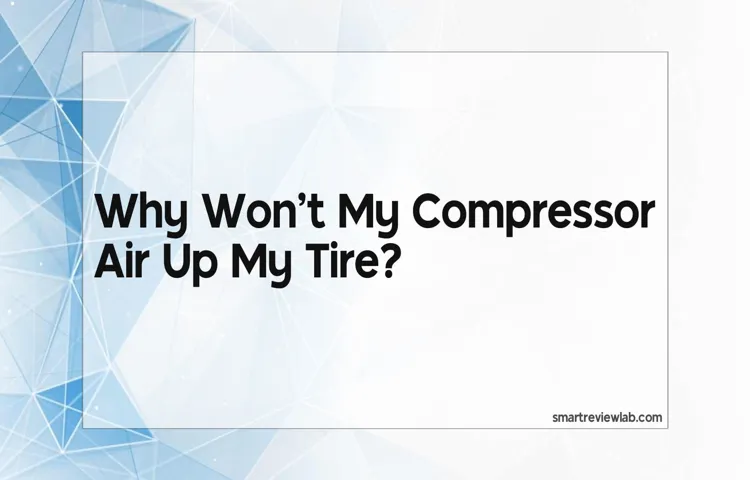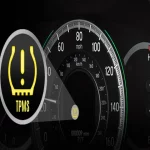Are you frustrated with the persistent flashing of the tire light on your dashboard? You’ve tried altering the tire pressure, but the light still remains illuminated, leaving you puzzled. Well, fret not, as you’re not alone in this ordeal. Many car owners find themselves in a similar predicament, wondering why the tire light won’t go off.
In this blog, we’ll dive into the possible reasons why your tire light is still flashing and explore some simple solutions to fix the issue. So buckle up and let’s hit the road!
Table of Contents
Check the Tire Pressure
If you have ever wondered “why won’t my tire light go off,” then the answer may be simpler than you think. One common issue that can trigger the tire pressure light is inconsistent air levels in your tires. If the pressure is too high or too low, it can cause the sensor to activate.
Take a moment to check the tire pressure in each of your tires using a quality gauge, and add air as necessary to bring all four up to the recommended levels. Remember that tires can lose air over time, so it’s good to make this a routine part of your regular car maintenance. By keeping your tire pressure balanced, you may be able to prevent the recurring annoyance of your tire light turning on.
Use a Tire Pressure Gauge
Tire pressure is an important aspect that you need to keep in mind if you want to keep your car in good shape for years to come. Too little pressure can damage your tires, and too much pressure can lead to a dangerous blowout. So, the first step to maintaining your car tire pressure is to get a tire pressure gauge.
It is an inexpensive device that you can easily purchase at your nearest auto parts store. To check your car’s tire pressure, simply remove the valve cap from the tire’s valve stem and place the pressure gauge onto the valve stem. Press down firmly on the gauge to ensure it is making proper contact with the stem, and then read the number that indicates tire pressure.
If the number is significantly lower than the recommended pressure, you need to inflate the tire. If the number is significantly higher than the recommended pressure, you need to let some air out. Regularly checking your tire pressure can go a long way in extending the life of your tires and keeping you safe on the road.

Compare with Recommended Pressure
When it comes to ensuring your vehicle is in top condition, checking your tire pressure is a crucial task that should not be overlooked. Maintaining the recommended pressure for your vehicle’s tires can increase their lifespan, improve fuel efficiency, and provide for a smoother ride. Checking your tire pressure is simple and can be done with a tire pressure gauge easily purchased at an auto parts store.
Start by finding the recommended pressure for your vehicle, which can typically be found on the driver’s side doorjamb or in the owner’s manual. Next, remove the valve cap from the tire and place the gauge onto the valve stem. Press down firmly, wait for the gauge to give a reading, and compare it to the recommended pressure.
If the pressure is too low, add air until it reaches the correct level. If it is too high, use a tire gauge to release some of the air until it reaches the recommended level. Remember to check your tire pressure regularly, at least once a month, to ensure maximum safety and performance on the road.
Inflate the Tire
Checking the tire pressure is crucial in ensuring that your tires are in good condition for safe driving. One of the main steps in this process is inflating the tire. Having underinflated tires can lead to poor fuel efficiency and even cause damage to your vehicle’s suspension system.
On the other hand, overinflation can cause the tires to burst and create hazardous driving conditions. It’s essential to note that every vehicle requires a specific tire pressure level recommended by the manufacturer. You can find this information in the vehicle manual or on a sticker inside the driver’s door.
Once you know the correct pressure, you can use an air pressure gauge to monitor the tire’s current level and add or release air accordingly. Overall, regularly checking and inflating your tires to the proper pressure level is a simple yet essential maintenance task that can impact your vehicle’s safety and performance on the road.
Check the Sensor
If you’re asking yourself, “Why won’t my tire light go off?” the first thing you should do is check the sensor. The tire pressure monitoring system (TPMS) sensor is responsible for detecting low tire pressure, which triggers the warning light on your dashboard. A faulty sensor can result in a false warning light or prevent it from turning off even though the tire pressure is normal.
You can diagnose a faulty sensor by using a TPMS tool or taking your vehicle to a mechanic. They will perform a test to determine if the sensor is working correctly. If it’s faulty, you will need to replace the sensor to fix the issue.
Keep in mind that TPMS sensors have a battery life of around seven to ten years, so if your car is older than that, it may be time for a replacement regardless of whether it’s faulty or not. With a functional TPMS sensor, you can rest assured that your tire pressure is where it should be, making for a safer and more efficient drive.
Clean the Sensor
Cleaning the sensor on your camera is an essential task to ensure that your photos turn out sharp and free from any unwanted specks or spots. A dirty sensor can cause frustrating blemishes on your images, especially when shooting at high apertures. Luckily, it’s easy to check if your sensor needs cleaning.
Set your camera to manual mode, set the aperture to its smallest setting, and snap a plain white image. Inspect the image for any noticeable spots or specs. If you find any, then it’s time to clean your sensor.
Keep in mind that avoiding manual cleaning can lead to more expensive repairs or even replacements. In addition to regularly checking your sensor, be sure to use a proper cleaning kit to remove any dust or dirt. For safety, it’s best to rely on a professional for cleaning the sensor, but you can always do it yourself with a few quick and easy steps.
Keep your camera sensor clean, and your images will turn out sharp and stunning every time.
Replace the Sensor Battery
The key to maintaining the accurate functioning of your sensor device is to ensure that the sensor battery is replaced on a regular basis. Regular checks on the sensor will help you determine whether the battery needs replacing or not. A low battery can cause errors within the sensor readings, which may affect the efficiency of your device.
You can check the sensor for battery status by using the display screen on the device itself, which will show any “low battery” warning messages. It’s essential to replace the battery as soon as possible to maintain the accuracy of your sensor readings. By doing so, you’ll ensure the longevity and proper functioning of your device and optimize its capabilities.
So, if you want to be sure that your sensor device is working correctly, make sure you check the sensor battery regularly and replace it as needed to avoid any potential issues down the line.
Reset the Sensor
If you’re experiencing issues with your sensor, the first step is to check it. Look for any signs of damage or wear and tear. If it looks damaged, it’s likely that it needs to be replaced altogether.
If it looks okay, try resetting the sensor. Sometimes, a simple reset can solve the problem. To do this, turn the sensor off and unplug it for a few minutes.
Once it’s been unplugged, plug it back in and switch it back on. This should reset the sensor and clear any issues it was experiencing. If the problem persists, it may be time to call in a professional to take a closer look.
Don’t wait too long to address any issues with your sensor as they can lead to larger problems down the line.
Visit a Mechanic
If your tire light won’t go off, it’s best to visit a mechanic as soon as possible. While it may seem like a minor inconvenience, ignoring the light can lead to major problems down the line. The light is typically an indicator that there’s something wrong with your tire pressure, which can result in decreased fuel efficiency, reduced handling, and even blowouts.
Your mechanic can examine your tire pressure sensors and diagnose any issues. They may simply need to reset the sensors, or replace them altogether. In any case, it’s important to address the issue promptly to ensure your safety on the road.
Don’t hesitate to visit a mechanic if your tire light won’t go off – it’s better to be safe than sorry.
Advanced Diagnostics
If you’re experiencing car troubles, it’s always best to visit a mechanic for advanced diagnostics. While there are plenty of DIY solutions available online, they often fall short when it comes to identifying the root cause of the issue. A mechanic has access to specialized equipment and expertise that can detect problems that would otherwise go unnoticed.
Additionally, a mechanic can provide a comprehensive inspection of your entire vehicle, ensuring that any minor issues are addressed before they turn into major problems. Not only will this keep your car running smoothly, but it can also save you money in the long run by preventing costly repairs down the line. So the next time you’re faced with a stubborn check engine light or a strange noise under the hood, don’t hesitate to make an appointment with your trusted mechanic.
Your car (and your wallet) will thank you!
Replace Faulty System Components
If you’re experiencing issues with your vehicle that you suspect could be caused by faulty system components, it’s important to visit a trusted mechanic as soon as possible. Ignoring the problem can lead to bigger, more expensive issues down the line. A mechanic will be able to diagnose the problem and identify which components need to be replaced.
Depending on the severity of the problem and the age of your vehicle, it may be more cost-effective to replace the component rather than attempt to repair it. Not only will this ensure a longer life for your vehicle, but also a safer driving experience for you and your passengers. Don’t put off visiting a mechanic to address your vehicle’s issues.
Your safety and the longevity of your vehicle depend on it.
Conclusion
It’s like your car’s tire light is a rebellious teenager – it just won’t listen to reason! But in all seriousness, there could be a number of reasons why your tire light won’t turn off, from low tire pressure to faulty sensors. Rather than resorting to duct tape and wishful thinking, take your car to a professional mechanic to get to the bottom of the issue and ensure your safety on the road.”
FAQs
What are the common reasons for tire pressure warning light to turn on?
The most common reasons for tire pressure warning light to turn on are low tire pressure, faulty sensors, and a punctured tire.
Will the tire pressure warning light go off on its own?
If the cause of the light turning on is low tire pressure, the light may go off on its own when the tire is properly inflated. However, if the cause is faulty sensors or a punctured tire, the light will not go off on its own.
How do I know if the tire pressure warning light is indicating a serious problem?
If the light starts to blink instead of staying on continuously, it indicates a serious problem that needs immediate attention.
Can I drive with the tire pressure warning light on?
While it is technically possible to drive with the tire pressure warning light on, it is not recommended as it increases the risk of tire blowouts and other tire-related issues.
How can I reset the tire pressure warning light?
The tire pressure warning light can be reset by inflating the tires to the recommended pressure and following the instructions in the car’s manual to reset the light.
Can extreme weather conditions affect the tire pressure warning light?
Yes, extreme weather conditions such as extreme cold or heat can cause fluctuations in tire pressure and trigger the tire pressure warning light.
Should I rely on the tire pressure monitoring system or check my tire pressure manually?
It is recommended to check your tire pressure manually at least once a month as the tire pressure monitoring system may not always be accurate.



